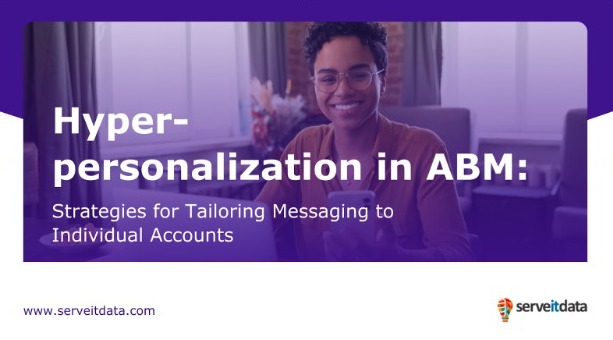Hyper-personalization in ABM: Strategies for Tailoring Messaging to Individual Accounts
Account-Based Marketing (ABM) has revolutionized the way B2B marketers engage with their target accounts. By focusing on individual accounts rather than broad audience segments, ABM enables marketers to create highly personalized and tailored experiences for each prospect. One of the key drivers of successful ABM is hyper-personalization, which involves crafting customized messages that resonate with the unique needs and challenges of each target account.

In this article, we will explore strategies for achieving hyper-personalization in ABM and how it can enhance the effectiveness of your marketing efforts.
Conduct In-depth Account Research:
To achieve hyper-personalization in ABM, it is crucial to invest time and effort into thorough account research. This includes understanding the account’s industry, business objectives, pain points, and decision-making processes. Leverage internal and external data sources, engage with stakeholders, and conduct interviews to gather insights that will inform your messaging and campaign strategies.
Develop Ideal Customer Profiles (ICPs):
Creating detailed Ideal Customer Profiles (ICPs) is a critical step in achieving hyper-personalization. ICPs outline the characteristics, challenges, and goals of your target accounts. By aligning your messaging with the specific attributes of each account, you can deliver tailored messages that resonate with their unique needs and priorities.
Segment Accounts Based on Persona and Stage:
Segmenting your target accounts based on personas and stages of the buyer’s journey allows you to deliver relevant messages that address specific pain points. Identify key personas within the target account and tailor your messaging accordingly. For accounts in different stages of the buyer’s journey, focus on addressing their specific concerns and providing the information they need at each stage.
Leverage Intent Data:
Intent data provides valuable insights into the activities and interests of your target accounts. By monitoring signals from various sources, such as website visits, content downloads, and social media engagement, you can gain a deeper understanding of account interests and intent. Utilize this data to deliver personalized content and messaging that aligns with their demonstrated interests.
Customize Content and Messaging:
Tailor your content and messaging to align with the unique challenges and objectives of each target account. Customize your website, landing pages, emails, and other marketing assets to address specific pain points and offer solutions. This level of personalization shows that you understand their business and positions you as a trusted advisor.
Utilize Dynamic Content:
Dynamic content allows you to create personalized experiences at scale. By using data-driven technology, you can dynamically change elements of your content based on the characteristics of the target account. This includes personalizing headlines, images, case studies, and testimonials to resonate with the specific needs and interests of each account.
Implement Personalized Campaigns:
Design and execute personalized campaigns that focus on the individual account’s goals and challenges. This can include tailored email sequences, personalized direct mail, and customized event invitations. By delivering campaigns that are relevant and meaningful to each account, you can capture their attention and drive engagement.
Leverage Automation and AI:
Leverage marketing automation and AI-powered tools to scale your hyper-personalization efforts. Automation allows you to deliver personalized messages and content at scale, while AI can analyze data and generate insights that inform your personalization strategies. These technologies enable you to efficiently deliver tailored experiences to a large number of accounts.
Measure and Iterate:
Measure the effectiveness of your hyper-personalization efforts and iterate based on the results. Analyze engagement metrics, conversion rates, and sales outcomes to assess the impact of your personalized campaigns. Use these insights to refine your messaging, targeting, and personalization strategies, and continually optimize your ABM efforts.
In conclusion, hyper-personalization plays a crucial role in the success of ABM. By investing in account research, developing ICPs, leveraging intent data, customizing content and messaging, utilizing dynamic content, implementing personalized campaigns, and leveraging automation and AI, marketers can deliver tailored experiences that resonate with individual accounts. By embracing hyper-personalization, B2B marketers can build stronger relationships, drive higher engagement, and ultimately achieve better results in their ABM initiatives.


